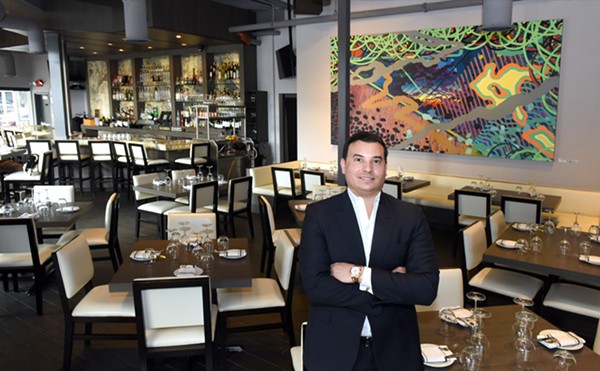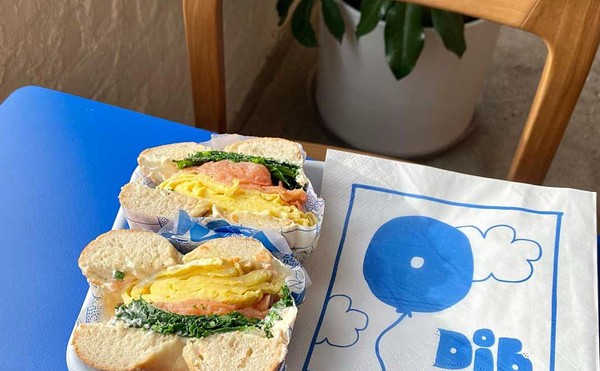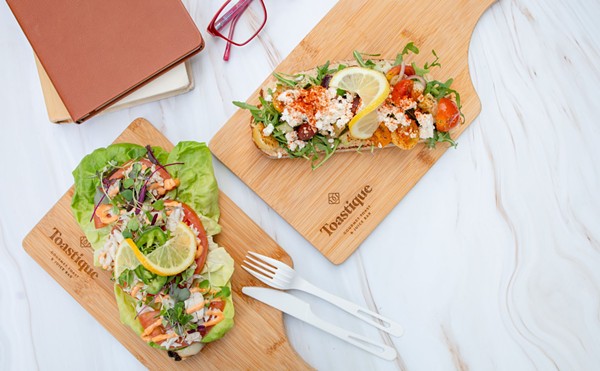Some find the water wall corny — a sheet of shining water cascading down the backdrop to Fusia's bar. I say turn off your "coolness radar" and take visual pleasure where you can.
Besides, no one could fault other, elegant aspects of the decor in the only pan-Asian restaurant downtown. The white linens are substantial, sauces are served in fetching little tilted bowls, square metal napkin rings match deep square plates, rounded sake glasses fit comfortably into your palm.
Fusia opened last August in tandem with two informal restaurants, now closed, all part of a planned "Asian Village" in a cavernous space just east of the Ren Cen. The plan at the time was "contemporary Japanese with European influences," but within a few months the restaurant had replaced its original chef, David Koshizawa, with local veteran Shawn Mac. Crain's Detroit Business quoted operations director Raymond Wong's reasoning: "The ingredients were too exotic, so we tuned down the menu."
The target customer is American, which is reasonable, given area demographics. Mac's experience in the suburbs at Forté and at French-Italian Boocoo, where he won high praise, qualify him to construct not-too-exotic versions of Asian dishes, or Asian versions of Western dishes, or Western dishes using ingredients with Asian names, that will please intended customers.
And they will, I can just about guarantee. Anyone who liked Mac's osso buco at Boocoo — or all the wonderful things he did there with duck — will love his beef short rib tempura and his Pekin duck and fresh mango spring roll.
Most dishes are Japanese- or Chinese-inspired, with a few Thai, one "Filipino-style," some scallops labeled "Tandoori-spiced," and a hot pot that's simply "Asian." The sushi menu includes both traditional Japanese offerings and American translations like the Philadelphia roll or a "Southern accent" roll with crawfish and mayo.
I found Fusia's sushi generous and OK. Even eel (unagi), my usual choice for its warm, high-umami sensation, seemed rather humdrum. (I'd been recently spoiled, though, by a sushi-making demonstration sponsored by the Japanese consul, and few could hope to compete with the freshness and authenticity of the ingredients there.) My trencherman companion was more than pleased with his portions.
Better were the small plates and entrées. A crunchy duck spring roll was succulent, and the tender rib tempura — unfortunately just in appetizer size — came with both miso-mustard sauce and a dark gravy with a kick. Huge salt-baked shrimp were served with vibrant spinach; the name is a misnomer since they're neither baked nor salty but rather flash-deep-fried, but hardly oily or heavy. (They're also available as an entrée.) A vegetable spring roll is similarly light. Other first-course possibilities are tuna tartare, beef potstickers and Kobe beef sliders in steamed buns.
My favorite entrée and, according to our server, a crowd-pleaser, was "spicy drunken tuna." Dressed with a citrus vinaigrette, it's cut into chunks to display the ruby interior, and its intense flavor is what we mean when we talk about umami.
Also good is wasabi pea salmon, which somehow manages to taste of wasabi without a lot of heat. (I learned at the consul's house, by the way, that real wasabi is rare, even in Japan; it's made from the root of a hard-to-get herb. Most chefs substitute horseradish mixed with food coloring.) It's served with perfect mushrooms.
The tandoori-spiced scallops, impeccably seared, don't feel Indian, though they come with a nutty curried red lentil salad; perhaps it's the bacon accompaniment. Grilled Kurobuta pork loin sounded like a girly dish, with its coconut risotto and mango-pineapple salsa, but the flavor was unaccountably acerbic; not a crowd-pleaser. That staple of Sichuan menus in this country, Kung Pao chicken, has been rejuvenated — transformed, really — as "Empress Kung Pao," with lobster, shrimp, scallops and almonds rather than peanuts.
It's good that Fusia makes no nods to American tastes in the dessert department: The only sweet on the menu is green tea ice cream. Can you imagine ordering a Snickers cheesecake after any of the dishes I've described?
Service is a little exuberant for an Asian restaurant (the "How you folks doin' tonight?" brand of conviviality), and occasionally slipshod; my wine was brought in a glass still wet from the dishwasher, and there's a slight general feeling of anxiety rather than confidence and serenity. It's often difficult to get through by phone; you may have to call Raymond Wong's cell.
Fusia is open for lunch and dinner on weekdays; on Saturdays, dinner is followed by DJs and dancing from 9 to 2. Careful: At night, the "coolness radar" will be switched on. As a member of the restaurant staff explained, "The restaurant converts to an after-hours nightspot for upscale professionals, with a premium bar and small plates." If you are upscale enough, professional enough and premium enough, you could check it out.
Jane Slaughter dines for Metro Times. Send comments to [email protected].






